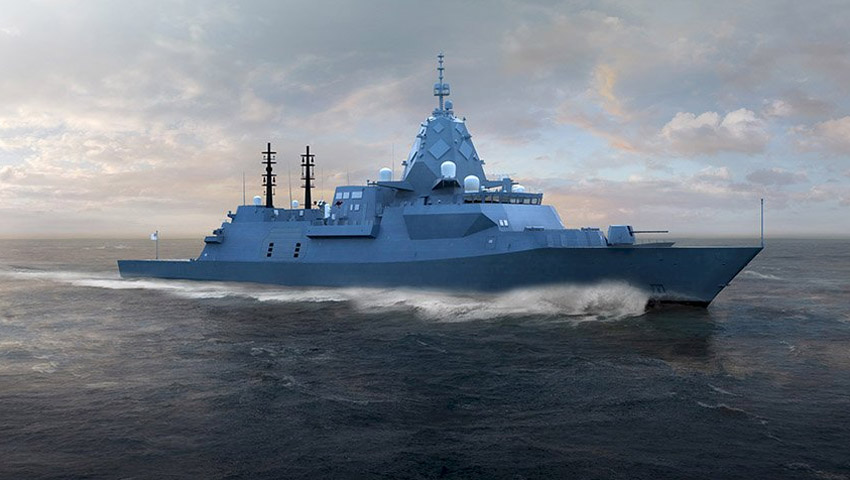Does Defence need to reconsider its shipbuilding strategy in light of challenges associated with the Hunter Class frigate program?
Earlier this week, findings from a classified “Engineering Team Assessment” of the Commonwealth government’s $45 billion Hunter Class frigate program were leaked to The Australian.
The report, presented to the Department of Defence, suggested the next-generation BAE Systems-built anti-submarine vessels would be “substantially” slower than initially anticipated, operating across a shorter range and leaving ships vulnerable to detection.
The 36-page report, tabled in November, also raised crew safety concerns, claiming personnel could be trapped below deck by floodwaters in “credible damage conditions”.
However, Minister for Defence Peter Dutton dismissed fears of a systemic issue with the project, stating the assessment is “only accurate in part”.
He stressed there would always be “an element of risk” involved in major defence projects, acknowledging “things will go wrong”.
Minister Dutton went on to downplay the weight of the assessment, describing it as a “low-level report”, which has been “exaggerated”.
Project cancellation was also ruled out as an option, with Minister Dutton confirming Defence would not pursue a “plan B”.
“[We] looked very carefully at this project and we've decided that we will proceed with it,” he said.
In a statement to Defence Connect, BAE Systems Australia stressed that identifying risks is “part of a normal design risk management process”.
“All large projects go through an engineering phase to identify and mitigate potential issues and we’re working to deliver the best outcome for our customer,” the spokesperson added.
“The Hunter Class frigate program is making strong progress towards the delivery of a superior anti-submarine warfare capability for the Royal Australian Navy.”
But according to Marcus Hellyer, a senior analyst for defence economics and capability at the Australian Strategic Policy Institute, the issues raised in the report could reflect deeper, underlying frailties with Australia’s shipbuilding program.
Hellyer notes that risks linked to the bespoke design of the Hunter Class frigates, modelled on the UK’s Type 26 design, were evident during the selection process.
“The future frigate selection process was meant to pick a mature design that was in the water and in service,” he writes.
“Instead, it picked an immature design as its reference ship that had barely started construction and was far from being in the water, let alone in service. The government also agreed to five major changes to the design, including installing the Australian-made CEAFAR radar and the US Aegis combat system.
“There’s no such thing as a completely off-the-shelf warship design, but the point of picking a mature, in-service design is to minimise changes and the technical and schedule risks that accompany them.”
Hellyer observes that the now-cancelled Attack Class submarine program had progressed further through the design phase than the Hunter Class project, claiming it was “considerably more mature”, with its “technical, cost and schedule risks better understood”.
The analyst rejects assurances from Defence that issues relating to the SEA5000 program would be addressed, stating Defence has “minimal credibility in the shipbuilding space”.
“For years, Defence assured Senate committees that the Attack Class would provide a regionally superior capability throughout its life, yet after the cancellation, the prime minister stated that the Attack Class would have been obsolete almost the minute it went in the water …,” Hellyer continues.
He goes on to lament delivery delays, with construction of the Hunter Class vessels now scheduled to commence in 2024, four years later than initially anticipated.
“At the business end of the project, initial operational capability – when the first vessel is ready to fight – is now 2034,” he adds.
This delay in next-generation naval warfighting capability could be compounded by the expected IOC date for the nuclear-powered submarines promised under the AUKUS partnership.
“The government’s $575 billion expenditure on defence in the 2020s, which includes $270 billion on new capability, will not get any frontline warships to sea this decade and likely none until the middle of next decade,” he observes.
“Meanwhile, the Anzac and Collins fleets will need to serve on into the 2040s, hopefully (but not assuredly) ageing gracefully. But if the brand-new Attack Class wasn’t going to be the undersea warfare capability we need, it’s hard to see the 40-year-old Collins providing it.
“The RAN’s entire warfighting capability is at risk.”
Hellyer calls on the government to proactively consider alternatives to avoid capability gaps in a heightened threat environment.
“We simply can’t afford to cross our fingers and hope that Defence can sort out the problems in the Hunter-class program,” he writes.
“Even if it can, the capability it delivers is too little, too late, at too great a cost – and may be irrelevant in the face of future threats.”
Among the alternatives proposed by the analyst are building more Hobart Class air warfare destroyers, arming the Arafura Class offshore patrol vessels with anti-ship missiles, ramping up investment in uncrewed and autonomous systems, and acquiring strike systems like the B-21 bomber.
“So far, Defence’s focus has doubled down on the shipbuilding program; indeed, the SSN program is sucking even more people and attention into that space,” Hellyer writes.
“But anybody with a basic familiarity with crew resource management will tell you that if everybody in the cockpit focuses on the flashing red light on the panel in front of them, the aeroplane will fly into a mountain.”
Get involved with the discussion and let us know your thoughts on Australia’s future role and position in the Indo-Pacific region and what you would like to see from Australia's political leaders in terms of partisan and bipartisan agenda setting in the comments section below, or get in touch with



